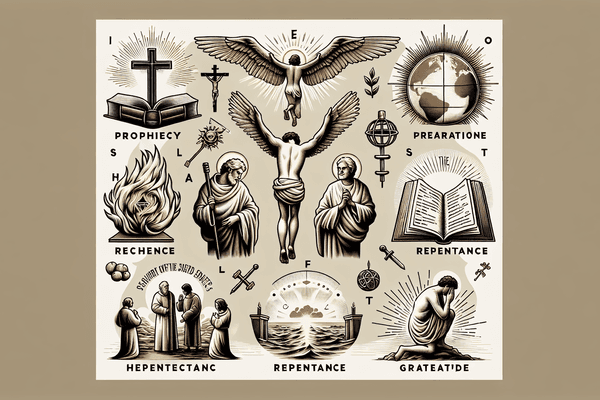Living in Christ
In Romans 13:14, believers are exhorted to 'clothe yourselves with the Lord Jesus Christ, and do not think about how to gratify the desires of the flesh.' This compelling metaphor suggests an intimate and transformative relationship with Christ, one that encompasses the entire being. To 'clothe oneself' with Christ means to adopt His virtues, to let His teachings reflect in every action, and to forsake the preoccupations with worldly desires that often lead astray. The Apostle Paul, in Galatians 3:27, reiterates this sentiment, 'For all of you who were baptized into Christ have clothed yourselves with Christ.' This donning of spiritual attire is a conscious and daily choice to emulate the righteousness and holiness that Christ embodies, a sentiment echoed in Ephesians 4:22-24 and Colossians 3:10. The challenge for modern believers is to navigate a world saturated with material temptations while holding fast to this spiritual garb, anchoring oneself to the enduring values of the faith as advised in 1 Peter 2:11 and living in a way that aligns with the will of God as enshrined in 1 John 2:15-17.
Denial and Faithfulness
The poignant moment when Jesus foretold Peter's denial, 'before the cock crow, thou shalt deny me thrice,' speaks volumes about human frailty and the struggle to maintain faith under duress. The fulfillment of this prophecy, as detailed in Matthew 26:34, serves as a stark reminder of our susceptibility to fear and weakness. However, the story does not end in failure; it is a testament to the power of repentance and redemption. Peter's bitter weeping, recounted in Luke 22:61-62, marks the beginning of a profound transformation. This narrative invites believers to acknowledge their shortcomings while embracing the opportunity for spiritual growth and restoration. It underscores the truth that, though we may stumble, as noted in Proverbs 24:16, the steadfast faithfulness of God, as affirmed in 2 Timothy 2:13, offers a path back to righteousness. The promise of forgiveness, extended to all who confess their transgressions, is beautifully encapsulated in 1 John 1:9.
The Twelve Disciples
The twelve disciples, handpicked by Jesus, represent a diverse group called to lay the foundations of the early church. Their selection signifies the deliberate formation of a community destined to carry forth the Gospel message. Each disciple brought unique strengths to their collective mission, contributing to the fledgling church's growth and resilience. Among them, Simon Peter stands out as a figure of paramount importance. Jesus' declaration in Matthew 10:1-4 that Peter, the 'rock,' would be instrumental in building His church, highlights the pivotal role he and his fellow disciples would play. The book of Acts, specifically Acts 2:14, depicts Peter's leadership and eloquence when addressing the masses. This early church, as described in Ephesians 2:20, was 'built on the foundation of the apostles and prophets, with Christ Jesus himself as the chief cornerstone,' a sentiment that resonates through the annals of Christian history. The ultimate recognition of their enduring legacy is symbolized in Revelation 21:14, where the city's foundations bear the names of the twelve apostles. For those seeking to nurture spiritual growth and family faith in today's world, the disciples' journey offers timeless insights.
The Power of God's Word
Hebrews 4:12 presents the word of God as 'living and active, sharper than any double-edged sword,' a passage that testifies to the dynamic and enduring nature of Scripture. The Bible's capacity to penetrate the heart and discern our innermost thoughts affirms its role as a divine tool for transformation and guidance. Isaiah 55:11 assures us that God's word accomplishes what He desires, a promise that encourages believers to engage deeply with Scripture. This engagement is not passive; as James 1:22 exhorts, it demands active obedience and application. The transformative potential of God's word is likened to a lamp that illuminates the path of the faithful, as celebrated in Psalm 119:105. The Bible's impact is powerful and multifaceted, serving not only as a source of comfort but also as a catalyst for change, much like the fire and hammer described in Jeremiah 23:29.
The Role of the High Priest
In the narrative of Hebrews, Jesus is exalted as the ultimate High Priest, one who is not distant or disconnected from human experience but deeply empathetic to our struggles. Hebrews 4:15 captures this beautifully, describing a High Priest able to 'empathize with our weaknesses.' This portrayal of Jesus challenges believers to seek a deeper understanding of their faith, recognizing the profound significance of having a mediator who has shared in human suffering. As the flawless High Priest, Jesus meets our needs, as described in Hebrews 7:26-27, offering salvation to all who obey Him, a point further emphasized in Hebrews 5:9-10. The imagery of Jesus as the mediator in 1 Timothy 2:5 reinforces the intimacy and accessibility of God through Christ. The hope and assurance provided by Jesus' priestly role is described as an 'anchor for the soul, firm and secure,' a truth that penetrates the heart and offers solace (Hebrews 6:19-20).
FAQ
Q: What does Romans 13:14 mean?
A: Romans 13:14 encourages believers to emulate the character and teachings of Jesus Christ, avoiding worldly desires and living a life that reflects Christian values and righteousness.
Q: What does 'before the cock crow, thou shalt deny me thrice' mean?
A: This phrase refers to Jesus' prediction that Peter would deny knowing Him three times before the rooster crowed, which indeed happened, illustrating human weakness and the need for faithfulness.
Q: How many disciples were there?
A: There were twelve disciples chosen by Jesus, known for their role in spreading His teachings and establishing the early Christian church.
Q: Is Simon and Peter the same person?
A: Yes, Simon and Peter are the same person. Simon was his original name, and Jesus later named him Peter, which means 'rock,' signifying his foundational role in the church.






